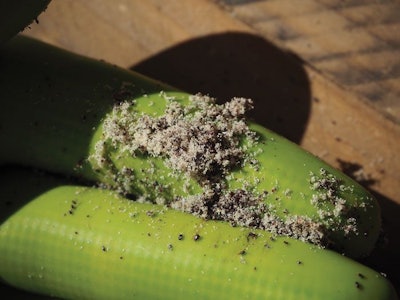
Poultry red mites are a small pest that have a large impact on the egg industry in terms of production losses and control cost, especially in the EU.
An epidemiological review found in the article, The Poultry Red Mite, A small pest that packs a big punch, by Monique Mul from Wageningen University & Research released in November of 2013, reports that 83 percent of the European farms are infested with poultry red mites. This harmful mite is extremely costly to the poultry industry; annual European industry losses alone are at EUR360 million (US$446.54 million).
This is an issue that has not yet impacted the U.S.
“In Europe, prevalence of [poultry] red mites is expected to increase, because of recent hen husbandry legislation changes, increased acaricide resistance, climate warming, and the lack of a sustainable approach to control infestations,” according to a scientific article: Poultry red mite (Dermanyssus gallinae) infestation: a broad impact parasitological disease that still remains a significant challenge for the egg-laying industry in Europe by Annie Sigognault Flochlay et al.

How poultry red mites differ from other pests
Dr. Annie Sigognault Flochlay, director, project management and pharmaceutical development at Merck Animal Health, discussed the differences between poultry red mites and other pests that may cause issues in poultry houses.
While the northern fowl mite is a common parasite in U.S. poultry operations, the poultry red mite offers some different issues. Unlike the northern fowl mite, poultry red mites live in cracks and crevices and only come out about one hour a night to feed off the host. Both types of mites live off the blood of the poultry that they bite, but the northern fowl mite can complete its entire life cycle without ever leaving a bird. Poultry red mites leave the host every day and can survive many weeks of starvation hiding in a housing system. Both types of mites are hard to control and need various forms of pest control options, Flochlay explained.
This is much like the fly. Successful fly control programs for layer operations in the U.S. commonly involve multiple interventions that target different stages of the life cycle of the fly. According to Flochlay, it is possible to have a program for poultry red mites that attacks multiple stages of the life cycle, because blood feeding life stages of the mite may feed on the same host, as the mite starts attacking at the protonymph stage.
When management treats the host (the bird) and not the environment they are able to treat all life stages because eventually the mite will develop into a blood feeding stage, she explained. This is unlike the fly.
Darkling beetles are another insect pest that seems to be very hard to control in poultry houses. This is the only similarity between darkling beetles and poultry red mites in terms of why they are so hard to control/eradicate because they are both capable of developing resistances to treatment methods.
Adult female poultry red mites lay their eggs in areas that are protected from treatment and birds. As previously stated, poultry red mites start feeding off the birds at the nymph state. This is different from the northern fowl mite who lays its eggs directly on the bird.
Aside from the egg, poultry red mites have four life-cycle stages which include; larvae, protonymph, deutonymph and adult. Protonymphs, deutonymphs and adult females routinely feed on host blood, but males only occasionally feed.
Once on a host, mites feed for short periods of up to an hour, doing so every two to four days and typically during periods of darkness. Complete development of a poultry red mite, from egg to adult can take as little as one week. If one mite has eight eggs per clutch, her offspring and their descendants can number 244,140,625 in just 12 weeks.
Why are poultry red mites so hard to control?
A very limited number of chemical treatments are currently available to treat poultry red mite infestations. “Many conventional mite products have been withdrawn from European markets or banned in the past few years because they did not comply with European or national regulatory requirements for human consumer and user safety,” Flochlay et al.
If you have a house that was previously infested, and you bring a new flock in, time needed for the residual mites to develop to an infestation level that requires treatment of the new flock will vary by farm. Producers along with the help of professionals and/or veterinarians can use specific mite surveillance methods and tools to determine the best time and method to treat, Flochlay explained.
Cage-free systems often make for a more complex environment which gives the mites more options for hiding. “Some studies have shown that mite infestation rates in traditional cage systems are lower than in alternative systems; however, some places in the world have very high infestation even in cages,” Flochlay said.
There are premise insecticides that will kill poultry red mites that can be used in non-poultry contact areas. However, those products and their availability vary in different countries, she explained. Most of them do not offer a recommended withdrawal time which is why they can’t be used in the presence of the birds. This may create a consumer safety issue for meat and eggs, she added.
Some non-chemical methods are being used to try and control poultry red mites, but these often don’t give adequate control. Often these methods result in a reduction to the number of mites but do not fully remove them, she explained.
In some cases predator beetles and mites have been introduced to the houses infested with poultry red mites, but results have been inconsistent.
There are insecticides that can be used in bird living areas that have some impact on various life stages of the poultry red mite. However, they must be government approved and in the case of Byemite, a concentrated emulsion containing phoxim, and organic phosphate, eggs laid during and after treatment for 12 hours must be destroyed . “This makes this method of cotrol not suitable for large intensive layer farmers,” she said.
“I’m not aware of any feed additives that help control poultry red mites,” Flochlay said.
New control method
Merck Animal Health (known as MSD Animal Health outside the United States and Canada) has developed a new treatment for poultry red mite infestations, EXZOLT, which is administered through drinking water.
The product, based on the fluralaner molecule, works on the parasites’ nervous system and kills mites that have taken a blood meal, while remaining safe for the host animal. Blood feeding stages are killed as soon as they feed on a treated chicken, and eggs and larvae are killed when they develop into a blood feeding stage. Under optimal conditions, eggs and larvae will reach that stage in about a week.
Fluralaner is now used as a topically applied flea and tick control for cats and dogs in the U.S.
Hens given up to three to five times the recommended dose of the fluralaner base product showed no negative effects on the number of eggs produced, the weight, or egg quality in research studies. It also had no effect on fertility, Flochlay noted.
At this time, the oral method of fluralaener treatment for poultry is approved by the European Commission for use in EU, and in several other countries around the world, Flochlay concluded.

















